-
-
Access Free Student Software
Ansys empowers the next generation of engineers
Students get free access to world-class simulation software.
-
Connect with Ansys Now!
Design your future
Connect with Ansys to explore how simulation can power your next breakthrough.
Countries & Regions
Free Trials
Products & Services
Learn
About
Back
Products & Services
Back
Learn
Ansys empowers the next generation of engineers
Students get free access to world-class simulation software.
Back
About
Design your future
Connect with Ansys to explore how simulation can power your next breakthrough.
Free Trials
ANSYS BLOG
October 24, 2022
An Extra Set of Eyes: Startup Employs Digital Twin Technology to Validate Injection Molding
Injection molding is perhaps the most common form of manufacturing around the globe due to its ability to scale production at mass. Essentially, the process involves injecting heated, liquefied plastic into temperature-controlled molds under high pressure and then cooling them. These plastic polymer materials are also known as thermoplastics and are pliable upon heating but solidify when cooled.
From bottle caps and toys to electronics and automotive parts, injection molding is a core component of mass production. However, while its capacity for repetition and consistency is appealing, one major challenge is avoiding design errors. An overlooked design error produced by the millions can significantly derail production timelines and budgets.
MAZIN Inc., an Industrial Internet of Things (IIoT) startup based in Japan, is developing a way to prevent this potential mass error by using sensors as another set of eyes through Ansys’ simulation solutions and digital twin technology.
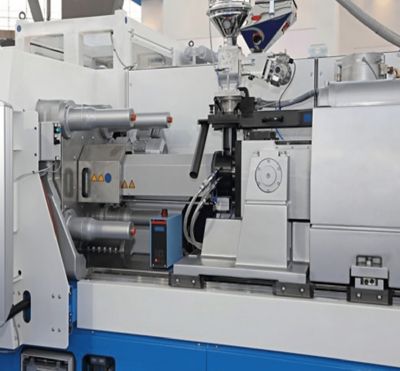
Mazin uses injection molding machines, equipped with sensors, to gather pressure fluctuation data that will be used within their digital twins.
Detection by Artificial Intelligence
Founded in 2018, MAZIN researches and develops artificial intelligence (AI) algorithms for IIoT platforms to help factories become “smart” factories by implementing AI technologies to assist production.
Recently, by integrating Ansys Twin Builder and PlanetsX, an Ansys add-on product provided by Ansys Elite Channel Partner Cybernet, engineers at MAZIN have developed an AI-based system to monitor condition adjustment during the injection molding process.
One of the top challenges in injection molding is controlling the resin flow into the molds. With the help of simulation, MAZIN is implementing virtual sensors to monitor this flow and improve accuracy.
“Our customers of injection molding have problems predicting resin flow in mold cavities and adjusting machine conditions to maintain product quality,” says Yusuke Uchiyama, research director of MAZIN Inc. in Japan. “To solve these problems and enhance the ability of predicting flow characteristics, we decided to employ Ansys simulation, which is useful and beneficial for both design and process engineers.”
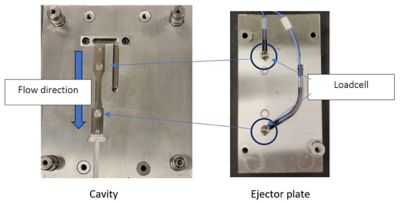
Mazin measures cavity pressure data with load cells on ejector pins (as shown above), and combines this measured data with the resin flow simulation by PlanetsX to create a ROM (reduced-order model) using ROM techniques from Ansys Twin Builder.
For example, Uchiyama and his team measured cavity pressure by installing load cell pressure sensors on the back of ejector pins throughout the upstream and downstream sides of each mold cavity of an injection molding machine.
Next, the group simulated the resin flow in PlanetsX to measure the pressure fluctuation caused by the force of the resin pushing against the ejector pins.
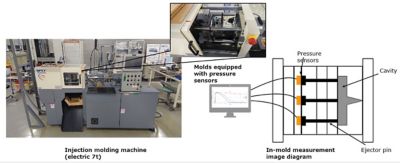
Left: Actual image of injection molding machine. Right: Positional relationship of sensor, cavity, and pin.
PlanetsX is a tool available through the Ansys Workbench simulation integration platform that provides consistent analysis of injection molding and supports warping simulation by using the flow history of linear and structural simulations. Warping, or warpage, is a defect that occurs when the desired shape of a molded part is distorted during cooling.
After combining the pressure data collected from the ejector pins with the result of the PlanetsX simulation, the team constructs reduced order models (ROMs) using ROM techniques from Ansys Twin Builder. With this information, Uchiyama and his team developed a decision tree classifier for the production quality of the injection molding. In AI and machine learning (ML), decision trees arrange the decision-making process in a step-by-step fashion to set up algorithms for AI that will draw needed information from the supplied data at each step.
The algorithm uses your simulation results and ROMs, applying estimated data as an output and experimental data as an input. To best achieve this, the algorithm uses the pressure sensor data from one observation point to estimate the pressure at an evaluation point in the ROM. As a result of this method, you can expand the amount of information based on a very small amount of sensor data.
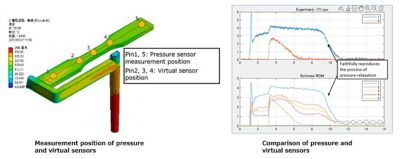
Left: Measurement positions of real and virtual sensors. Right: Time series waveform of pressure showing real sensor data (upper side) and virtual sensor data (lower side).
Breaking the Mold: Winning Results
Uchiyama says the ROM builder was particularly beneficial.
Twin Builder uses ROMs produced from Ansys structural, fluids, electromagnetics, and semiconductor products to model mechanical assemblies, thermal integrity, and more.
In this project, MAZIN constructed ROMs by applying neural networks, which are deterministic models having known inputs. In future stages of the project, the team plans to develop stochastic reduced models with unknown inputs and variables.
ROMs can be created in Twin Builder. Co-simulation with 3D physics solvers preserves the full accuracy of finite elements analysis (FEA) and computational fluid dynamics (CFD) for modeling fluid components, flow networks, mechanical assemblies, and more.
In addition to the recent injection molding project, MAZIN has developed anomaly detection AI systems for turning and machining centers.
“We began to use Ansys Twin Builder to enhance productivity for our customers in manufacturing processes — for instance, in cases of turning and machining processing, injection molding, die casting, and so on — to be able to provide physical insight for our customers during their manufacturing processes,” says Uchiyama. “Using ROM technology through Ansys Twin Builder reduced our overall simulation time by about 50-70%.”
For the injection molding project, MAZIN engineers ran pass or fail tests to determine molding defects or failure, also known as short shots, and the success of sensor prediction. In injection molding, short shots occur when the mold cavity cools before it is completely full, which results in an incomplete part.
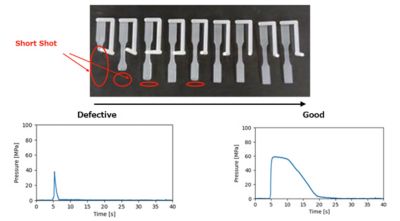
Top: Images of when a short shot occurs. Bottom: Pressure time-series waveform when a defect occurs and when a good product is produced.
After assessing the short shot test results, the engineers concluded that the data and predictions obtained from the virtual sensors were highly accurate.
While accuracy is a top priority in both injection molding and any manufacturing process, sustainability has become an equally important goal.
With increasing environmental awareness driven by global warming concerns and carbon neutrality initiatives, expectations for high efficiency and energy-saving processes in injection molding are growing each year.
MAZIN is confident that simulation can help the group reach sustainability goals and believes Twin Builder has already helped reduce the carbon footprint for its customers.
“In the process of injection molding, operators usually discard products until the injection machine leads to a stable state of producing viable parts,” says Uchiyama. “With digital twin technology, the lead time to a stable machine state is shortened and therefore the carbon footprint for our customers is reduced.”
Success at Scale
Interest has already grown for the Japanese startup throughout the country. Global Brain, a venture capital firm based in Japan, recently announced its support of MAZIN as a lead investor.
As MAZIN continues to expand business, Uchiyama says his team intends to keep simulation and digital twin technology as core components of a successful operation.
“From an engineering perspective, using simulation enforces the strength of our products,” says Uchiyama. “From a business perspective, it contributes to our branding strategy as a technology startup company.”
What’s next? MAZIN plans to use simulation to identify defects other than short shots, including burr (excess of molding), shrinkage (contraction of molding), and silver streaks (silver marks in molding caused by air pockets trapped during a rapid start of injection).
Additionally, the team would like to create virtual sensors for conditions outside of pressure by using combined measurements for flow velocity and temperature.
To learn more about MAZIN, visit their website.